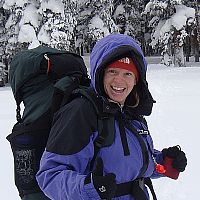Swetish et. al., 2012
Influence of understory greenness on trace gas and energy exchange in forested ecosystems
Swetish J., Papuga S. A., Litvak M. E., Barron-Gafford G. A., Mitra B. (2012)
Abstract B51B-0511 presented at 2012 Fall Meeting, AGU, San Francisco, Calif., 3-7 Dec (Poster)
-
Catalina-Jemez, UNDERGRAD
-
Catalina-Jemez, INVESTIGATOR
-
Catalina-Jemez, INVESTIGATOR
-
Catalina-Jemez, INVESTIGATOR
Abstract
Forested ecosystems are important sources and sinks of carbon, water, and energy – affecting land surface – atmosphere interactions at multiple scales. Understanding how forested ecosystems will respond to climate change is critical for quantifying how they will feedback with the climate system. Addressing this need is challenging in forested ecosystems because of their complex structure and composition, both vertically and horizontally. Here we highlight the different functioning of the main overstory canopy and the more seasonal understory. Both the overstory and the understory contribute differently to the exchange of carbon, water and energy with the atmosphere. Both eddy covariance measurements and remotely sensed products can provide ecosystem-scale estimates of trace gas and energy flux, but the contribution of the understory to these estimates remains relatively unexplored. In this study, we aim to address the contribution of the understory to ecosystem-scale carbon uptake. Specifically, we ask the following questions: (1) how big is the contribution of the understory to ecosystem carbon uptake?, (2) at what times of year is the understory contribution important?, (3) does the eddy covariance carbon uptake signal (NEE-) reflect the greening up dynamics of the understory?, (4) is the greening up dynamics of the understory captured in our remotely-sensed products?, and (5) can remotely-sensed vegetation products such as MODIS-derived NDVI and EVI accurately reflect ecosystem-scale carbon uptake dynamics? To address these questions, we use three years of eddy covariance data from two similar subalpine mixed-conifer ecosystems within the Jemez River Basin – Santa Catalina Mountain Critical Zone Observatory (JRB-SCM CZO). The mixed-conifer site at the JRB is at roughly 3000 m and has substantial understory, while the mixed-conifer ecosystem of the SCM is at roughly 2500 m has very minimal understory. Within the footprint of the eddy covariance towers at both sites, three time-lapse digital cameras (phenocams) take hourly images of the understory from which a greenness index (Ig) is calculated. We show that daily NEE- and Ig are generally synchronized, suggesting that the understory may substantially contribute to ecosystem-scale carbon uptake. However, while remotely-sensed vegetation indices and Ig are synched at certain times throughout the study period, often they are not. For instance, in 2010 NDVI remains higher for a longer period than does Ig. This suggests that relying solely on remotely-sensed products may lead to an overestimation of carbon sequestration by these ecosystems. We argue the contribution of the understory to ecosystem-scale carbon, water, and energy exchange with the atmosphere is important and therefore critical to understanding how climate change will alter their feedback with the climate system.
Citation
Swetish J., Papuga S. A., Litvak M. E., Barron-Gafford G. A., Mitra B. (2012): Influence of understory greenness on trace gas and energy exchange in forested ecosystems. Abstract B51B-0511 presented at 2012 Fall Meeting, AGU, San Francisco, Calif., 3-7 Dec (Poster).
Explore Further




